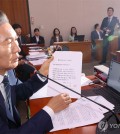- California Assembly OKs highest minimum wage in nation
- S. Korea unveils first graphic cigarette warnings
- US joins with South Korea, Japan in bid to deter North Korea
- LPGA golfer Chun In-gee finally back in action
- S. Korea won’t be top seed in final World Cup qualification round
- US men’s soccer misses 2nd straight Olympics
- US back on track in qualifying with 4-0 win over Guatemala
- High-intensity workout injuries spawn cottage industry
- CDC expands range of Zika mosquitoes into parts of Northeast
- Who knew? ‘The Walking Dead’ is helping families connect
U.S. sent ATACMS missiles to Ukraine following Russia’s use of N.K. missiles: White House
The United States has shipped longer-range tactical missiles to Ukraine for use in the fight against Russian forces following Moscow’s use of North Korean ballistic missiles against the war-torn country, the White House confirmed Wednesday.
National Security Adviser Jake Sullivan said that in February, President Joe Biden directed his aides to provide Ukraine with a “significant” number of the Army Tactical Missile Systems (ATACMS) missiles for use inside the Ukrainian territory and that the shipments have arrived in the country.
“(The arrival) followed Russia’s procurement and use of North Korea’s ballistic missiles against Ukraine, as well as Russia’s renewed and escalating attacks against civilian infrastructure in Ukraine,” Sullivan told a press briefing.
He added that Washington plans to send more missiles, but he did not specify the shipment volume due to “operational reasons.”
“I believe they will make a difference,” he said.
The missile deliveries came before the U.S. House of Representatives voted Saturday to endorse a US$95 billion aid package for Ukraine, Israel, Taiwan and others in an approval that ended a monthslong political impasse.
The provision of the missiles with a range of about 300 kilometers marked a policy shift. Sullivan said that the U.S. was unable to send ATACMS missiles due to “readiness concerns.”
“But behind the scenes, the administration across the board has worked relentlessly to address those concerns,” he said. “We now have a significant number of ATACMS coming off the production line and entering U.S. stocks, and as a result, we can move forward with providing ATACMS, while also sustaining the readiness of the U.S. armed forces.”
Sullivan warned that the “path ahead” will not be easy as Russia will double down on its attacks. But he expressed confidence in Ukrainians’ endeavors to repel invaders.
“Over time, we assess that Ukraine’s position in this conflict will improve, and we believe that Ukraine can and will win,” he said. “As I’ve said from this podium before, no one in this room, and no one anywhere else should underestimate the Ukrainian people, and no one should underestimate President Biden’s resolve and the American people’s resolve.”
Asked to comment on suspected military ties between North Korea and Iran, Sullivan pointed to “linkages” in defense cooperation between the two countries.
“Episodically, over the course of many years and many administrations, we’ve seen various linkages in defense cooperation between North Korea and Iran that’s come and gone, ebbed and flowed,” he said.
What is new or different over the course of the last two years is cooperation between Russia and Iran and between Russia and North Korea, Sullivan noted.
“We believe that this is a matter of grave concern to the security of Europe, way beyond the borders of Ukraine,” he said. “We’re also concerned about what may happen in the other direction. What is Russia going to provide to North Korea or Iran that will destabilize the Indo-Pacific or destabilize the Middle East?”











